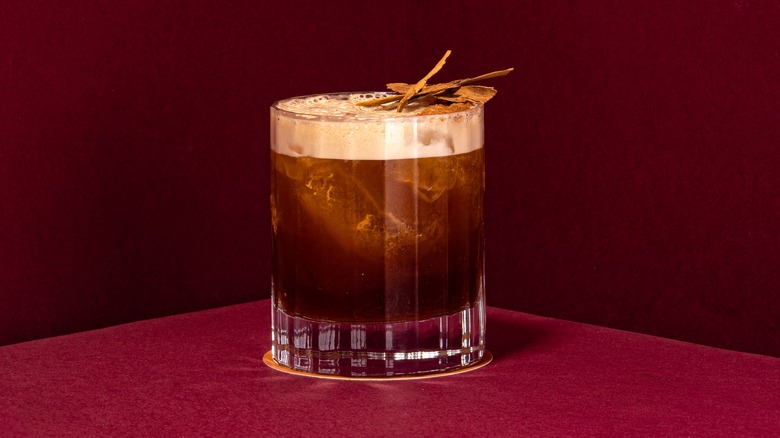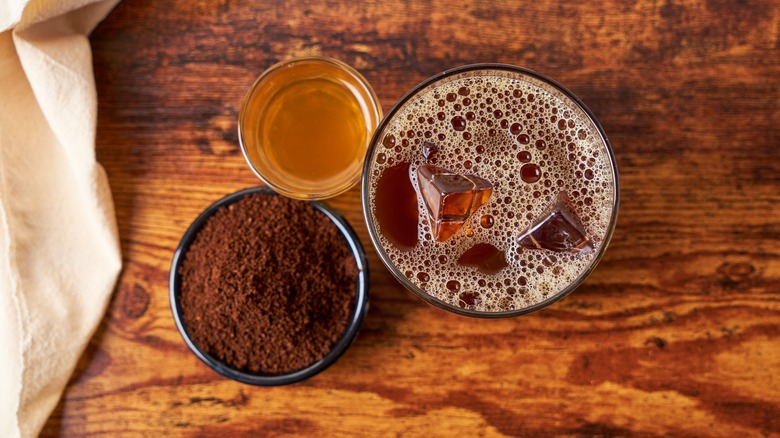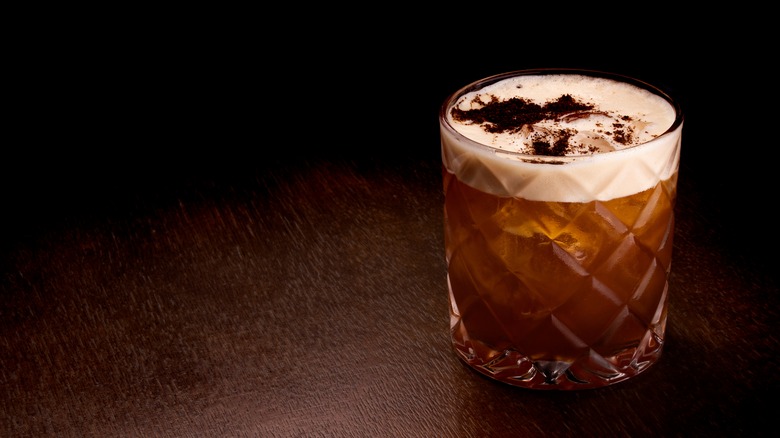After Trying Carajillo, I'm Never Going Back To The Espresso Martini
The night I first tried a carajillo began like many other nights out with my friends. I was nearly asleep on the couch, probably watching some form of reality television, when my roommate came out into the living room in disbelief — she was ready, and I, very obviously, was not. Despite my fatigue, the potential FOMO seeped in, and 15 minutes later, I was ready to go. Little did I know that this night would be one I'd never forget: The night I ordered a carajillo instead of my usual espresso martini.
It happened at San Diego bar called Born & Raised. There, underneath the dimmed lighting and swanky, old Hollywood interiors, was where my night took the unexpected turn. While, at the time, I can admit that I'd never even heard of a carajillo, I was convinced within my first sip: the carajillo was everything my basic espresso martini could've been, but simply never was.
Served in an 8 oz rocks glass, with one large ice cube and a fresh orange peel, the carajillo even looks cooler than your flimsy espresso martini. The weight of the glass only plays on the depth of the drink. Here, the espresso is paired with Licor 43, which gets its name for all of the different spices and botanicals it contains, and its forefront flavors of vanilla and citrus make the carajillo what I like to think of as the Starbucks latte of coffee cocktails. It's light and sweet, has aromatics of vanilla, orange bitters, and chocolate, and it's all sealed away in a velvety smooth texture that lathers your tongue with every sip. It's an all-around winner, sweeter, and more refreshing than your basic espresso martini — and it's an ideal way to kick off your night.
A tasty Mexican tradition
Despite my ignorance, the carajillo is a ubiquitous drink in Mexico, where it has become an emblematic part of the sobremesa tradition of drinking and conversing after a meal. Served at virtually every cantina, coffee shop, and old-school restaurant in Mexico City, carjillos in Mexico are typically ordered one of two ways: "puesto," where the coffee and Licor 43 are visibly separated in your glass, and "shakeado," where the two are shaken and combined, giving you that nice frothy finish.
Even though I enjoyed mine as my first drink of the night — giving me the mood lift and the boost of caffeine I so desperately needed — carajillos are traditionally enjoyed after dinner. It would make a wonderful dessert drink, especially if you have late plans for afterward. However, before they became Mexico City's party drink, carajillos were enjoyed just as much in the mornings before work or as a midday pick-me-up in countries like Cuba and Spain. Personally, I have no reservations regarding either. As I said, it's the Starbucks latte of coffee cocktails, and I think a carajillo is just light enough that it would taste fabulous at any time of the day — and, unlike an espresso martini, it'd pair just as well with your breakfast as it would your dessert.
The case for carajillos
It's no secret that the carajillo has been making moves south of the border, where you can even spot billboards that entice you with sayings like "stay up with Carajillo." But it's still not too late to hop on the cocktail trend that's been growing in popularity in the U.S. for quite some time now, too — with press reports claiming the carajillo as one of the fastest-growing cocktails as early as 2020.
While it may not be quite as common yet, carajillos can be found on the menus of most Mexican restaurants and drinking establishments, especially in the south and southwest. Given the Mexican influence, carajillos are more common in cities like Houston, Texas, and Los Angeles, California, but also major cities like Chicago, Miami, and New York City. But, no matter where you are, it never hurts to ask the bartender if you're not seeing it on the menu.
Incredible flavor and cultural capital aside, the carajillo is also a game changer for myself and others who deal with an aversion to dairy. This has always been a hindrance when ordering the espresso martinis I had in the past. Without it, I'd be missing out on that creamy mouthfeel and the inherent smoothness the milk lends to the drink. But, with the carajillo, I don't miss out on anything. Made from a 1:1 ratio of coffee and Licor 43, there's no dairy involved — but the carajillo is still far smoother than any espresso martini I've had before.


